Where The Gays Are
A breakdown of new survey data.
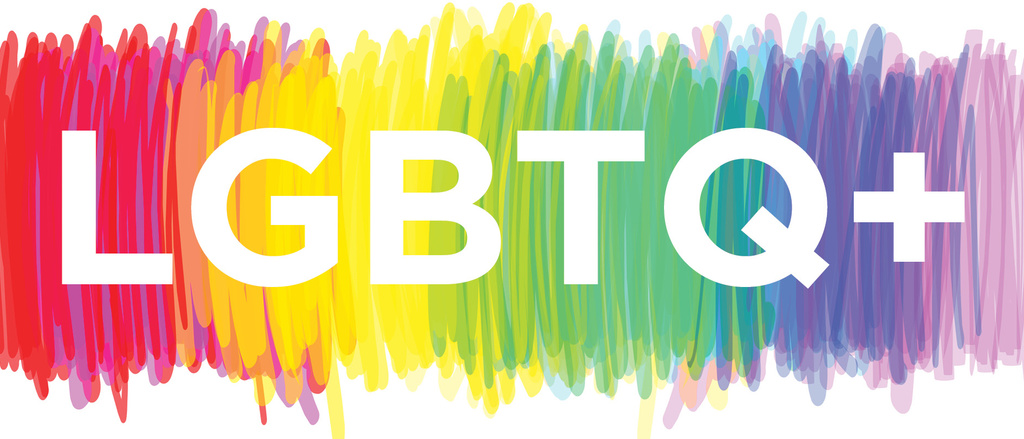
I was amused by The Hill‘s report “These states have the most LGBTQ residents: research.”
California has the largest number of LGBTQ Americans, according to new research, while Washington, D.C., has the greatest percentage of LGBTQ residents and the South claims a larger share of LGBTQ adults than any other region.
A report published by the Williams Institute[*] at the University of California, Los Angeles found an estimated 5.5 percent of U.S. adults, or about 13.9 million people, identify as LGBTQ, based on data from the Centers for Disease Control and Prevention from 2021-22.
About 14.3 percent of D.C.’s population identifies as LGBTQ, while Oregon and Delaware, coming in at second and third, have LGBTQ populations of 7.8 and 7.5 percent, respectively,
Vermont and New Hampshire are close behind — 7.4 and 7.2 percent, respectively, followed by Washington state at 6.9 percent and Colorado and Maine, where LGBTQ residents accounted for 6.8 percent of each state’s population.
California, the largest state by population, has the most LGBTQ residents — 1,549,600 — followed by Texas’s 1,071,300 and Florida’s 898,000. New York is close behind with 853,600 residents before the number drops to 586,500 in Pennsylvania, followed by 557,600 in Ohio. The top 10 is rounded out by Michigan, Illinois, Georgia and Washington.
Nearly 36 percent of LGBTQ Americans live in the South, which researchers defined as stretching from Texas and Oklahoma to Florida and north through Delaware. Kentucky, West Virginia, and D.C. are also included, per USA Today.
The Midwest holds 21.1 percent of LGBTQ Americans, while the Northeast has 18.5 percent.
The report separately found young adults — ages 18 to 24 — take up the largest share of LGBTQ Americans, at 15.2 percent. That’s equal to nearly 1 in 6 young adults in the U.S., or about 4,659,600 people.
I was immediately reminded of this:
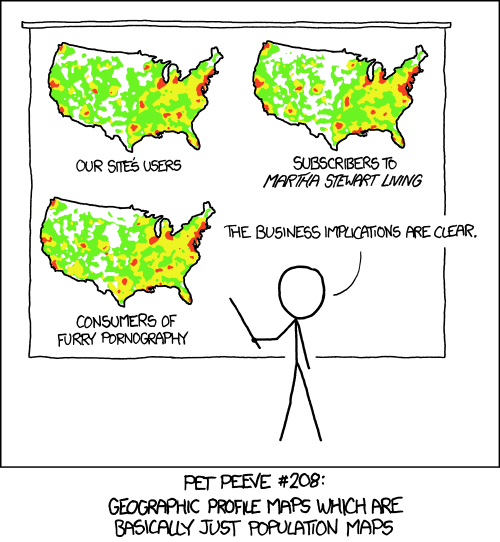
Indeed, the top 5 most-LGBT** states and the top 5 states by population coincide exactly. The next five are ranked 7, 10, 6, 8, and 13 by population—but they’re much more closely clustered than the top five, both in terms of population and the number of LGBT adults counted.
The percentage figures are more interesting but would be much more so with some multivariate analysis. Mostly obviously, how does the percentage of LGBT-identifying individuals correlate with the age demographics of the state? Ditto the urban-rural demographics?
As highlighted in The Hill’s coverage, the age differences really jump out:
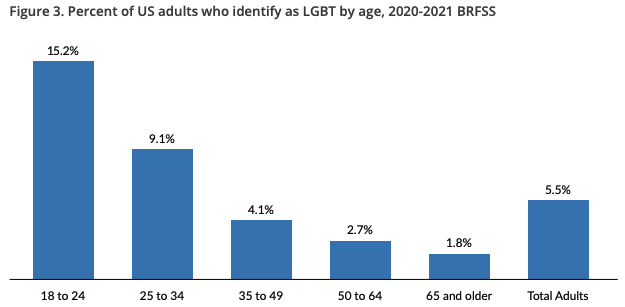
So, for example, DC is far and away the most-LGBT “state.” But of course it is: it’s a very small city. Further, it’s considerably younger than the US population as a whole.
Otherwise, the distribution differences aren’t all that stark:
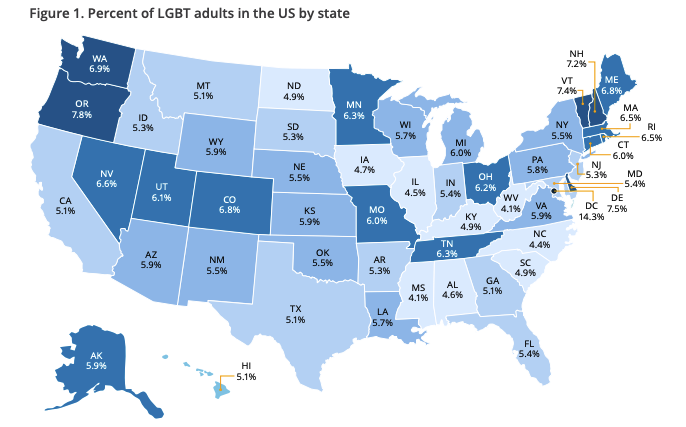
Among the 50 states, we see a low of 4.1% in Mississippi and a high of 7.8% in Oregon. I suspect that most of that variation goes away when accounting for demographics.
And some of it is no doubt simply a function of the survey methodology itself:
The Behavioral Risk Factor Surveillance System (BRFSS) is a state-based system of health surveys
coordinated by the Centers for Disease Control and Prevention and conducted in partnership with
states, the District of Colombia, and three U.S. territories.3 Every year an anonymous, self-report
survey is conducted by telephone with representative samples of non-institutionalized adults who live
in each state.[…]
Sexual orientation is measured with one question, “Which of the following best represents how
you think of yourself?” with response options, “Gay or lesbian; Straight, that is, not gay; Bisexual;
Something else; I don’t know the answer” or respondents could refuse to answer. To assess
transgender and cisgender status, the BRFSS module asks, “Do you consider yourself to be
transgender?” with response options, “Yes; No; Don’t Know/not sure” or respondents could refuse to
answer. If a respondent expresses confusion, then interviewers provide definitions of transgender
and gender nonconforming. If respondents affirmatively answer the question, they are then asked if
they consider themselves to be male-to-female; female-to-male; or gender nonconforming.In order to produce stable estimates of LGBT prevalence, we pool the data from the 2020 and 2021
BRFSS surveys; 37 states, and Guam used the SOGI module once or twice in this timeframe (n =
484,477). Twenty-nine states used the SOGI module in 2020 and 2021 and eight states used the
module in only one year. All respondents who were asked their sexual orientation identity were
coded as one if they identify as LGB and zero if they did not, which includes not sure, don’t know, and
refusal responses. All respondents who were asked whether they identify as transgender are coded
as one if they did or zero if they did not, which includes don’t know responses, not sure responses,
and refusals to answer. A respondent who was LGB and/or transgender was classified as LGBT (1), all
others were classified as not LGBT (0).We directly analyze and present the results from any state that implemented the SOGI module in
2020, 2021 or both years. More specifically, our prevalence estimates of the LGBT population for
the 37 states that used the BRFSS SOGI module in one or both years are the same as the weighted
statistic one would obtain from direct analyses of BRFSS data for those years.4
For states and the District of Columbia (DC) where the SOGI module was not used in either 2020 or
2021 and therefore no estimates of the LGBT population can be calculated directly—we use small
area estimation strategies common in demographic research with poststratification techniques
common in survey research.
One imagines that there’s a higher likelihood of LGBT individuals claiming to be straight or simply refusing to answer the question to a stranger calling on the telephone would be higher in the South and other more conservative parts of the country. And some states don’t administer the question at all, forcing the researchers to rely on estimation techniques. That’s a perfectly valid research technique but makes comparing relatively small differences fraught.
Because the questions relied on here are binary, it’s hard to know what to make of the results. There are the obvious demographic differences between the states already addressed. But one would certainly imagine that young LGBT adults would be inclined to move to places where they feel more comfortable living openly. Since there is no questioning along those lines, though, the report provides no insights on the why behind the observed differences.
_______________
*It’s worth noting that the Williams Institute, housed at UCLA’s School of Law, is “dedicated to conducting rigorous, independent research on sexual orientation and gender identity law and public policy” and “disseminates its research to policymakers, judges, the media, and other stakeholders to ensure that decisions impacting the lives of millions of LGBT people and families are based on data and facts.” Its founding “goal was to replace the pervasive bias against LGBT people in law, policy, and culture with independent research on LGBT issues.”
**For whatever reason, the research team consistently used “LGBT” rather than “LGBTQ” or other variants. I follow their model, since it’s quite possible that the addition of Q and other options would have at least slightly changed their findings.


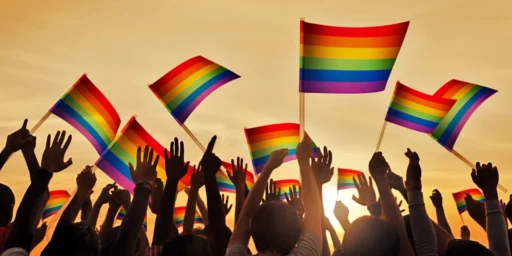
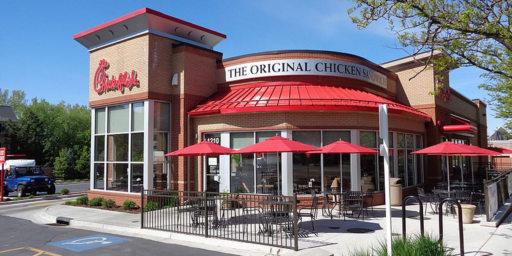

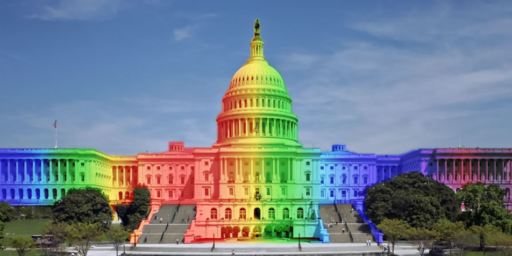
If you don’t know whether or not you’re transgender, you’re probably transgender. The realization that, no, most people don’t spend huge amounts of time worrying about their gender identity was one of the things that finally got me to self-accept. It sounds silly now, but for most of my life I sincerely thought all bisexual people wanted to be a blend of both genders.
For the most part I don’t care about the “Born This Way” stuff, as people should be able to love who they want for any reason, whether or not they were born a certain way. Basically, none of my business. But the nerd in me can’t help but see how uniform the percentage is across all kinds of States. Basically, 5% of the population self identifies as gay and that is true in open and liberal states as it is in the most repressive anti-gay States in the country. That’s gotta be a tick in the “Born This Way” column.
I have spent many a frustrated meeting trying to explain to people who oversee our recruiting efforts that most of what they claim are successful strategies are almost certainly just a result of population density.
@Steven L. Taylor: It’s even more bizarre that two PhD researchers at one of the world’s elite universities didn’t see something that was obvious to me instantaneously.
Telephone survey? I never answer a call not in my contact list. I can’t imagine not hanging up if some unknown person starts to ask personal questions.
@Slugger:
I don’t do phone surveys either.
Want to drive the surveyor nuts? Ask them what underwear do they have on.
I could always tell them my dung beetle story. They will probably hang up before I’m finished.
Northern New England clusters around 7%, despite not being all that populous.
@Jen: Gotta find some way to stay warm in the winter…
I mean, I wonder why? It couldn’t be because Ronald Regan, (rot in fucking hell) and the AIDS crisis destroyed a generation. It’s also probably not because every LGBT person over say 35 experience crippling systemic violence over who they are and who the love. So many older LGBTQ people are deeply closeted and crushingly afraid of being outed and their lives destroyed.
I help lead a fairly large trans group her in Chicago. We skew very young. We don’t have any official count of our members, but we average around roughly 40 people per week at our in person meetings. Of those 40 people about 25-30 of them are under 30. Say another roughly 10ish are in their 40s. We have three members older than that. 3. All 3 of them transitioned in their 70s. They are the strongest people I know. They have seen and lived some shit.
@Stormy Dragon:
Like, it’s so dumb. Cis people just don’t think about their gender. Like, at all. I think I got 10% smarter when I didn’t have to spend all that time thinking about performing gender correctly.
@Beth:
So, maybe this is the place to ask some pronoun advice.
I’m a straight cis male (that’s Doctor Privilege to you), but I almost never think of myself in those terms. I would happily use gender neutral pronouns all the time, especially online, because I think it generally shouldn’t be important what gender I am. At the same time, using those pronouns could be seen as making a positive statement about being nonbinary, and I don’t want to be misleading or disingenuous. But if I assert he/his pronouns, I seem to be making a statement about maleness being more important to my identity than it is.
So, at present, I seldom specify pronouns — which could also be taken as dismissing the legitimacy of that practice, which I also don’t want to do.
Suggestions welcome.
@DrDaveT: I use he/him in the email signature at work, and in certain social spaces. I think the idea is that when everybody does it, there’s no confusion, which creates a more welcoming environment for trans and nonbinary folks.
Now, it’s worth mentioning that my RL name is one that sometimes leads people to misidentify me as a woman in email exchanges (I’ve had people write back to me addressing me by the title Ms.), so for me using he/him solves that problem. Honestly, though, that’s never mattered to me much. I use he/him for inclusivity sake, not for my own benefit.
My only hesitation over using it is getting flak from people who dislike it.
@Beth:
So not true. Many of the world’s problems come down to men proving they are MEN. There is pressure on us from early on. We’re supposed to be tough, resilient, emotionally restrained, fearless and prepared at any moment to fight. Even now the onus is on men to be the primary provider. And we are meant to be protectors. If I’m walking down the street with my wife and daughters and trouble rears its head, guess who is supposed to wade into it with their creaky bones and atrophied muscles? In fact, under my self-definition, I’m meant to step up any time someone’s being bullied, particularly if the someone is female, and yes, I have done so and have put myself in danger on more than one occasion. Why? Cuz I’m a MAN, dammit.
I’m not complaining about any of this, I’m of the generation of men who were supposed to be MEN and MEN don’t whine. And by the way, the chief enforcers of this paradigm are often women. Which, again, is fine with me, I’m thoroughly brainwashed – if I get stabbed or shot protecting someone I’ll count that as a good death. But I do rather resent the notion that being a man is all privilege and smooth sailing. We die years earlier than women.
In fact men are seen as relatively disposable. Ever notice how every murder cop show involves a female victim? It’s not just prurience, it’s the fact that audiences DGAF if a guy gets it in the back of the neck, doubly so if the dude is Black or brown.
@Kylopod:
Specifying pronouns is good, as long as it’s not required, because that can put closeted trans and nonbinary folk in a painful position. There’s very little social risk for a cisgender man announcing he uses the he/him pronouns everyone thought he used anyways. If you’re a closeted trans person, there’s often significant cost in announcing that, but having to repeatedly misgender yourself also feels like absolute shit.
Again, up until about two years ago, I was always terrified whenever the subject of pronouns came up because I didn’t want anyone to ask me what mine were, because I had no reason to answer anything other than “he/him”, but I somehow subconsciously knew that I did not want to have to say that. If other people called me “he/him”, that was one thing, but saying it myself felt like a betrayal for some reason.
The other wrinkle is that I have actually use different pronouns in different contexts even after coming out. Around “normal people” I use they/them because even getting people to do that is hard enough, but among my close friends there’s a set of neo-pronouns I use.
@Stormy Dragon: Whenever I see anything about “pronouns” and putting them in parentheses, I’m so tempted to say that I insist on using “wagahai”….
(The whole pronoun thing looks very odd from a Japanese language perspective where the pronouns have more to do with class than gender.)
@Michael Reynolds:
You are so, so, close. And yes, cis men are massively harmed by the gender roles the are assigned. No doubt. The best way I can explain what I mean is with this:
https://youtu.be/FbcGxkQystM?si=-2r3PmFRGrdtmgl4
Cis men think about gender like Armond wearing the suit. It doesn’t fit right and they might kill themselves because of it, but they can make it work without thought.
The trans experience of gender is much like Albert. To make it all work you have to work so hard and think about it all the time and you still get it wrong. And people get mad at you and no one understands why. It’s because you work so hard to be something you’re not and can never be.
I recently watched that with my partner and cried through the whole thing. Afterwards I texted my friend Michael and told him that he and I would retire to Palm Springs and be those queers. Michael is basically a real version of Albert.
My partner just turned to me and was like “you were Albert.” And she cried. She never cries.
@DrDaveT:
You could use a nice he/they. Or Dr/He/They if ya nasty. That would signal to most people that you’re comfortable either way. And honestly, if you’ve put this much thought into it, you’re probably less binary than you think. For example, I’m super binary. I’d never be caught dead using they/them.
@Beth:
It’s the 15% of 18-24, and 9% of 24-35 that surprises me. What makes Millennials so much more likely to be closeted than Zoomers? Did society change that much? Why wouldn’t they just leave the closet now? Is it that they were raised by Boomers?
@Michael Reynolds:
Those are boys trying to prove that they are MEN. It’s just that some never get there and have to keep trying.
Alternately, perhaps a massive number of men are genderless (google, google… agender!), and don’t question their gender or feel like they have to prove anything because they don’t really care, it’s a default societal role they are given and it’s the easy one. I’m not sure that we could tell.
Imagine if some fish didn’t get oxygen from the water, they got it from some entirely magical means. Pull a bunch of fish out of water, and some are flailing around dying and others are just uncomfortable, and they wouldn’t have any inkling of difference beforehand. Is there some way to do a similar test with men?
I don’t think about my gender. The closest I come to thinking about my gender is thinking that I would really rather not have any facial hair — I can’t grow a beard, so shaving is just work rather than a choice to not have a beard. That’s it. And I doubt that’s any different than wanting to be about 4” shorter so I can buy clothes at normal stores.
I’m aware that being a dude means things are easier in our society, just as being White means things are easier. And that’s dumb, but at least I’m on the easier side (there is an objectively better side to be on). But I don’t think about my Whiteness.
Honestly I kind of lump the people who think about their MANLINESS and those that think about their WHITENESS in the same bucket: assholes.
@Gustopher:
It’s important to remember the belief that being LGBT was morally acceptable was a minority opinion in the US as recently as 2008: https://www.statista.com/statistics/226147/americans-moral-views-on-gay-or-lesbian-relations-in-the-united-states/
@Stormy Dragon: But why stay in the closet in this, the year of our Lord, 2023?
25-34 seems way too young to just settle into an uncomfortable habit, and there are so many examples of people who have come out and been happier for it. Did no one notice Pete Buttigeig?
@Gustopher:
I’m reminded of the story about a visitor asking a mahout how he manages to control an elephant with such a tiny rope, and the mahout responds that as a baby the elephant was tied with a chain and that by the time it had grown, it never thought to test the bonds, even though it could now easily break them.
25 is old enough to have received a generation of indoctrination from your family and community, and those bonds are not so easily cast aside.
@Gustopher:
Family, work, church/temple, political allegiance to the party that wants to eat your face, self-repression, fear, intimidation, the current environment in many places, trauma, psychological issues, and I suspect there’s more.
@Gustopher:
In addition to Kathy’s list, being married to (or in a long-term relationship with) a straight member of the opposite sex will put a serious crimp in your willingness to publicly assert LGBTQ+ status, even “anonymously”.
@Gustopher:
A dear friend of mine would have happily, gleefully even, gone to his grave closeted. An ill timed bout of covid did that in for him. He was in his 40s and a staunch Republican.
My guess is Millennials came of age at the end of the bad times and that trauma stayed with them. The Zoomers started coming of age in the good time. That’s why it’s so awful what Republicans are doing now.
@Beth: The delta between 9% and 15% just seems preposterously large. It means that there are 3 out Millennials for every 5 out Zoomers. In a few years, 66% more people were out of the closet.
And if anything, the 18-24 cohort are more likely to be financially dependent on their parents, and in a much more precarious position to be out.
I can’t say that the data is wrong, but it isn’t granular enough to show where the change is coming from, and it is enough of a shift that there should be an explanation. (I’ve skimmed over the report, and they don’t do breakdowns by letter in LGBT, or finer age breakdowns, or income…)
Maybe it’s just that nonbinary and trans people are more visible, and more politically active (asserting your identity is political), and the garden variety gays are seeing a more modest increase. (Trans folks are a big shift, but I don’t think they are nearly as common as lesbian, gay or bisexual folk)
Maybe definitions have changed and more kids are including furries or polyamorous folks in LGBT. Or asexuals.
Maybe the random sampling wasn’t random. Or perhaps young straight people are more likely to be ducking calls assuming that they are from collection agencies or some other completely insane unexpected complication.
The numbers raise more questions than they answer, and it’s a very hard thing to get reliable measures of, so I want to see those questions answered before I accept it as not an outlier.
ETA: is it a big shift in some demographic coming out? So many questions that this study doesn’t answer.